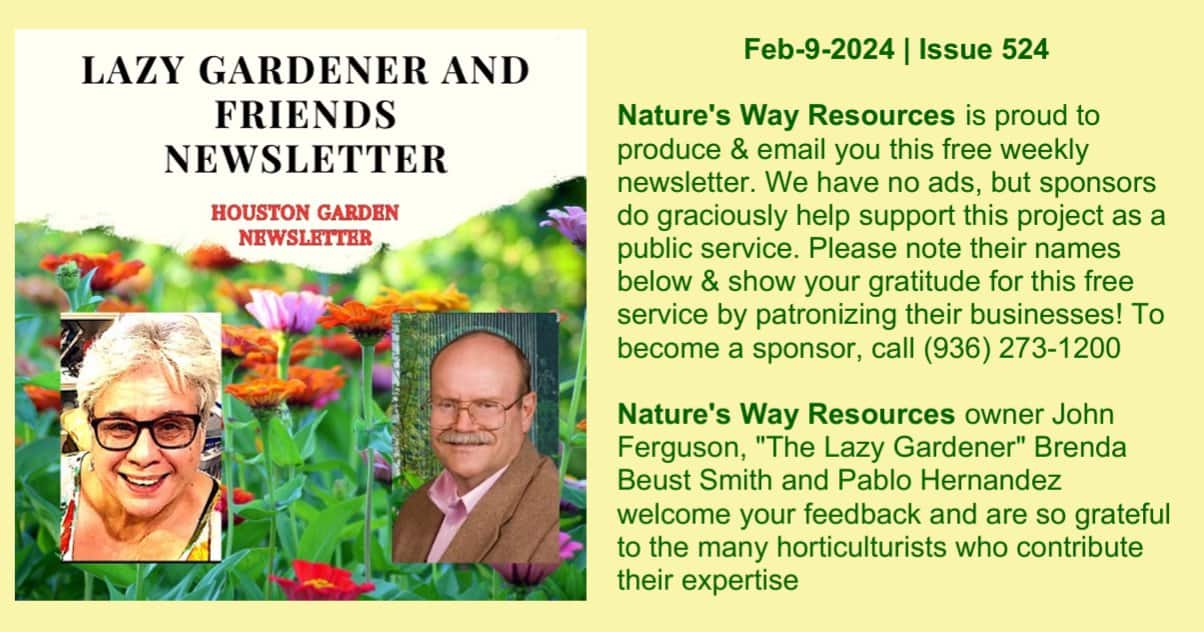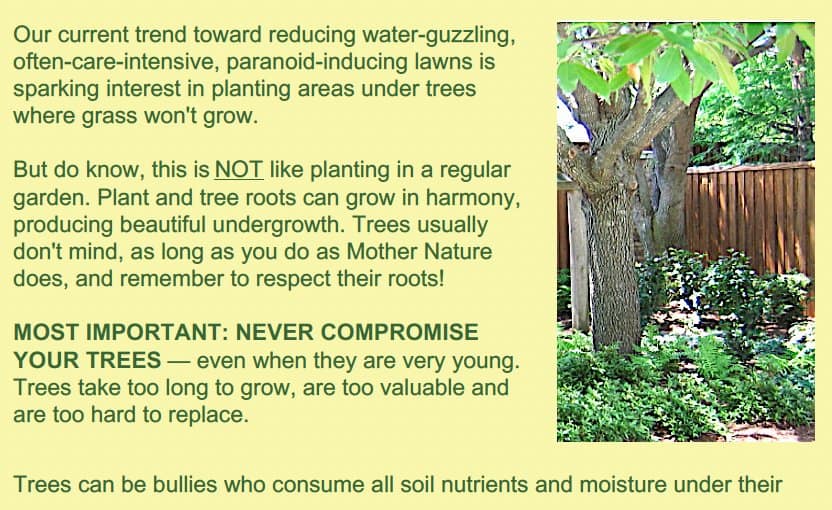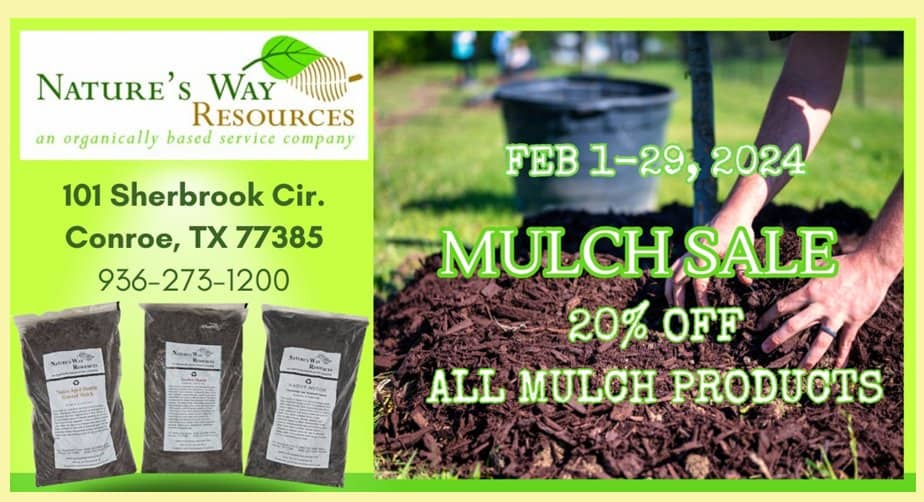
“The most interesting plants grow in shade” — Wednesday Adams in “Wednesday” — Addams Family Netflix spinoff
PLANTING UNDER TREES IS POSSIBLE — WITH GREAT CARE!
By BRENDA BEUST SMITH

canopy if you’re not careful. We’re moving into one of our best planting times (late Feb-March). Now’s a good time to start such a project. Tips from pros:
- Border potential no grass area under trees with a hose. Follow canopy’s outline. Looks more natural/ “professionally planned” than straight lines.
- Mow around the planned border before final decisions. Make adjustment to create an easily-mowed pattern. Don’t create extra work for yourself!
- Border outer area with rocks, bricks, plants, landscape timbers — anything that will help keep grass from growing in there. (IT WILL TRY TO!)
- Fill enclosed area with the tree’s own leaves — they’re a tree’s very best fertilizer. That’s how Nature fertilizes native trees.
- Set a CYLINDER — open bottom, NOT pot with small hole — in enclosed area on top leaves/soil. Fill with good soil/compost. Cylinder should be at least 6-8″ deep & 10-12″ wide if possible. Slightly taller and/or wider, doesn’t matter.
- Plant variety of shade-lovers at first (such as l-to-r below: columbines, chocolate plants and cane (etc.) begonias. That way you can see which you like and — more important — WHICH LIKE YOU!.

7. Cover new/young plants in winter. If worried, carefully lift cylinder enough to slide a bottom cover underneath. Lift and move inside. You’ll lose some roots, but many should be fine. I personally pile leaves up around outside plants, cylinder and all. If they don’t come back out in spring, try something else.
8. Water and fertilize right into cylinder, save time/energy/money. (I never fertilize. Decaying leaves decaying do job for me.)
9. By time plant roots reach soil below cylinder, falling leaves will be composting, adding nutrients. Roots will easily penetrate and co-mingle with tree roots without damaging either one. Slow root growth is what you want.
Gradually plants will spill over cylinder top and, on own, may root in soil below. Cylinder provides above-ground dry zone in which to maintain healthy root growth during heavy rains. What we need are more strong attractive cylinders.
SUZZANNE CHAPMAN, retired Mercer Botanic Gardens Botanical Collections Curator and “Center for Plant Conservation Champion” reports Mercer uses clay chimney flue liners from Acme Brick for plants like agaves for extra drainage.
At right are cylinder plantings you can see right now — Mercer has large clay flues at Storey Lake with displays of Louisiana Iris (should bloom in early April). Each LA named variety is planted separately.

LA rhizomes spread and can intermix with each other. Other cylinders come in a variety of sizes and shapes, with lower ones for under-tree planting and others with trailing plants
At her own home, Suzzanne’s cylinders still house Agaves and Texas native plants that need great drainage, since the flues are open top and bottom! She adds: “I love them because they blend well with clay pots.”
TRUTH IN GARDENING: Actually almost all my property’s border plants are in cylinders, in fact, most still in their original nursery plastic pots, I just cut the bottom off, dig a shallow hole, plop the pot in, plant ‘n’ all, 2/3rd above ground. I pile leaves around to hide the pot top, so neighbors won’t think I’m crazy.
It’s my favorite gardening method. Almost every one I’ve done that with has survived. (Well, the cassia did die back in the snow of 2018. But I’m patient. Several years ago it finally came back out and now blooms beautifully!)



NEWS FROM THE WONDERFUL WORLD OF SOIL AND PLANTS # 272
Subject: glyphosate food contamination sweeteners PFAS organic food
I often talk about glyphosate-based herbicides and all the health and environmental damage they cause. A new study from the University of Illinois with support from 24 other universities, has found the effectiveness of glyphosate is declining.
The researchers found that for some species it was 100% effective when first
introduced. Today the effectiveness has fallen to below 50% for many species and even below 30% for others. Journal PNAS Nexus (2023)
The organization “Moms Across America” funded testing on food from Americas top 10 most popular fast-food chains. They found two types of animal antibiotics and animal contraceptives in the food. The testing was done by the non-profit Health Research Institute.
Another reason to avoid fast foods and grow one’s own fruits, herbs, and vegetables organically. Or at least buy organic when one can and avoid GMO’s.
Speaking of food and health, artificial sweeteners have been linked to the soaring obesity and type 2 diabetes along with other health issues including increase risk of cancer.
A new study published in the journal Nature Medicine (2023) has found the sweetener erythritol is associated with an increased risk of major heart attacks and strokes.
Gardeners who want non-sugar alternatives can grow the herb Stevia (Stevia rebaudiana) or Aztec Sweet Herb (Lippia dulcis).
I have grown Aztec Sweet herb for decades as it makes a drought and heat tolerant perennial ground cover that grows in any soil including heavy black clay.
When my sweet tooth acts up, I use a raw unfiltered wildflower honey as it does not contain toxins or pollen from GMO’s. Raw honey also provides many health benefits.
A study by Keck School of Medicine at the University of Southern California has found that the chemicals known as PFAS, “alters several critical biological processes, including metabolism of fats and amino acids…” Journal Environmental Health Perspectives (2023)
For gardeners, a major source of exposure is fertilizers (Milorganite, Houactinite, etc.) and compost made from sewage sludge. Biosolids is the marketing name for sewage sludge.
Several companies in our area sell products like biosolid compost or soil blends made with biosolid compost directly. They also sell biosolid compost to small independent dirt yards to blend into their products.
See “News From the Wonderful World of Soil and Plants” issues 201-204 for detailed information on the dangers of these type products.
Another reason to grow our fruit and vegetables organically was found by Newcastle University in the UK.
They found that organic milk and meat contains 50% more beneficial omega-3 fatty acids that conventional.
Organic also had higher levels of fat-soluble vitamins like vitamin E and carotenoids plus 40% higher CLA.
Organic crops were found to be 60% higher in key antioxidants in addition to less heavy metals. British Journal of Nutrition (2016)
SPONSORSHIP
If you are interested in becoming a sponsor, please contact us at 936-273-1200 or send an e-mail to: lazygardenerandfriends@gmail.com

ABOUT US
BRENDA BEUST SMITH WE KNOW HER BEST AS THE LAZY GARDENER . . . but Brenda Beust Smith is also:
- a national award-winning writer & editor
- a nationally-published writer & photographer
- a national horticultural speaker
- a former Houston Chronicle reporter
When the Chronicle discontinued Brenda’s 45-year-old Lazy Gardener” print column — started in the early ’70s as a fun side-project to reporting, it then ranked as the longestrunning, continuously-published local newspaper column in the Greater Houston area. The name, she says, is not just fun, it’s true. Brenda’s gradual sideways step from reporter into gardening writing led first to an 18-year series of when-to-do-what Lazy Gardener Calendars, then to her Lazy Gardener’s Guide book which morphed into her Lazy Gardener’s Guide on CD, which she now emails free upon request. Brenda became a Harris County Master Gardener and, over the years, served on theboards of many Greater Houston area horticulture organizations. She hosted local radio and TV shows, most notably a 10+-year Lazy Gardener specialty shows on HoustonPBS (Ch. 8) and her call-in “EcoGardening” show on KPFT-FM. For over three decades, Brenda served as Assistant Production Manager of the GARDEN CLUB OF AMERICA’S “BULLETIN” magazine. Although still an active broad-based freelance writer, Brenda’s main focus now is THE LAZY GARDENER & FRIENDS HOUSTON GARDEN NEWSLETTER with John Ferguson and Pablo Hernandez of Nature’s Way Resources. A native of New Orleans and graduate of St. Agnes Academy and the University of Houston, Brenda lives in Humble, TX, and is married to the retired Aldine High School Coach Bill Smith. They have one son, Blake. Regarding this newsletter, Brenda is the lead writer, originator of it and the daily inspiration for it. We so appreciate the way she has made gardening such a fun way to celebrate life together for such a long time.
JOHN FERGUSON John is a native Houstonian and has over 27 years of business experience. He owns Nature’s Way Resources, a composting company that specializes in high quality compost, mulch, and soil mixes. He holds a MS degree in Physics and Geology and is a licensed Soil Scientist in Texas. John has won many awards in horticulture and environmental issues. He represents the composting industry on the Houston-Galveston Area Council for solid waste. His personal garden has been featured in several horticultural books and “Better Homes and Gardens” magazine. His business has been recognized in the Wall Street Journal for the quality and value of their products. He is a member of the Physics Honor Society and many other professional societies. John is is the co-author of the book Organic Management for the Professional. For this newsletter, John contributes articles regularly and is responsible for publishing it.
PABLO HERNANDEZ Pablo Hernandez is the special projects coordinator for Nature’s Way Resources. His realm of responsibilities include: serving as a webmaster, IT support, technical problem solving/troubleshooting, metrics management and quality control. Pablo helps this newsletter happen from a technical support standpoint.
Download the Newsletter with Our Events Calendar Below!

